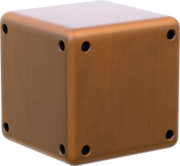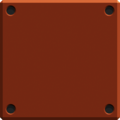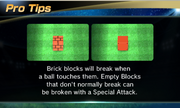Welcome to the new Mariopedia!
Empty Block
It has been requested that this article be rewritten and expanded to include more information.
- Not to be confused with Block.
An Empty Block (sometimes referred to as a Steel Block[1] or simply as a Block[2]) is a type of block in the Mario franchise that usually replaces a ? Block, an item-holding Brick Block, or a Coin Block when Mario or another character hits it, usually by jumping beneath it. Some Empty Blocks are already in an empty state. Empty Blocks have a blank appearance, and are usually brown in color.
History
Super Mario series
Super Mario Bros. / Super Mario Bros.: The Lost Levels
Empty Blocks debut in Super Mario Bros. and recur in Super Mario Bros.: The Lost Levels. In these games, they are colored to match the level's theme, like Brick Blocks and ? Blocks.
Super Mario Bros. 3
Empty Blocks return in Super Mario Bros. 3; both these blocks and ? Blocks are yellow (brown in remakes) in this game. Big Empty Blocks also debut in this game, being the result of hitting Giant ? Blocks; they also form part of the level designs of Worlds 4-2 and 4-5.
Super Mario Land
Empty Blocks return in Super Mario Land, acting as in prior games. They also occur naturally empty, mostly as bonus room terrain.
Super Mario World
In Super Mario World, Empty Blocks have small, closed, angry eyes in their sides' centers, rather than their usual holes. If the player hits a blue Switch Block, all Empty Blocks turn into coins and vice versa for a short time.
Super Mario Land 2: 6 Golden Coins
In Super Mario Land 2: 6 Golden Coins, Empty Blocks, looking like they do in Super Mario World, appear in the same capacity as in prior games.
New Super Mario Bros. series
Empty Blocks return in the New Super Mario Bros. games, working as they did previously; they are color-coded according to their environment, as in Super Mario Bros. They can now be broken by Mega Mario (in New Super Mario Bros. and New Super Mario Bros. 2) or stronger enemies, such as Broozers (in all games), King Bills (in New Super Mario Bros. Wii and New Super Mario Bros. U), and Super Bowser (in New Super Mario Bros. Wii).
Big Empty Blocks also return in red and orange Toad Houses in New Super Mario Bros. (as a result of hitting their respective blocks), World 6-5 in New Super Mario Bros. Wii, and Soda Jungle in New Super Mario Bros. U; Long Empty Blocks return in New Super Mario Bros. 2.
Super Mario Galaxy / Super Mario Galaxy 2
Empty Blocks appear in a 3D Super Mario game for the first time in Super Mario Galaxy, and they return in Super Mario Galaxy 2; however, they are always found naturally empty, as Brick Blocks always shatter when hit, even if they contain items, and ? and Coin Blocks vanish once used up.
Giant Empty Blocks also appear in the Supermassive Galaxy in Super Mario Galaxy 2, where they are part of the stage's level design.
Super Mario 3D Land
Empty Blocks return in Super Mario 3D Land, working as they do in the 2D games. Giant Empty Blocks are also found in hidden rooms accessed via Warp Pipes (as well as in World 6-3) and are often put together to form sculptures that create 3D illusions.
Long Empty Blocks also debut in this game, as a result of hitting Long ? Blocks.
Super Mario 3D World
Normal-sized and long Empty Blocks return in Super Mario 3D World, acting as they do in prior games. Certain ? Blocks also produce lines of Empty Blocks when hit, similar to face blocks from Super Mario 3D Land; giant versions of these blocks (though with a normal-sized "?" mark) also appear and make Giant Empty Blocks.
Super Mario Maker / Super Mario Maker for Nintendo 3DS / Super Mario Maker 2
Empty Blocks return in Super Mario Maker, Super Mario Maker for Nintendo 3DS, and Super Mario Maker 2, working as they do in the New Super Mario Bros. games. In Super Mario Maker 2, giant Empty Blocks also appear in the Super Mario 3D World style, as ! Blocks take the role that Mega ? Blocks did in the actual game.
Super Mario Odyssey
Only normal Empty Blocks reappear in Super Mario Odyssey. They can be found naturally empty in 8-bit sections.
Paper Mario series
Empty Blocks appear in all Paper Mario games, working as in the main series. Giant Empty Blocks return in Mondo Woods in Paper Mario: Color Splash.
Super Smash Bros. series
Empty Blocks also appear on Mario-themed stages in the Super Smash Bros. series.
Super Smash Bros. Melee
They first appear in Princess Peach's Castle in Super Smash Bros. Melee, if the red, blue, or green ! Blocks are touched or hit (or if items are turned off).
Super Smash Bros. Brawl
In Super Smash Bros. Brawl, ? Blocks on Mushroomy Kingdom become these if hit or jumped into from below, and they are refilled when the stage loops; they are made of wood with metal borders, and like the rest of the stage, they look more realistic.
Super Smash Bros. for Nintendo 3DS / Wii U
In 3D Land in Super Smash Bros. for Nintendo 3DS and Super Mario Maker in both the Nintendo 3DS and Wii U versions, they act the same as in Brawl but have their respective appearances; Empty Blocks are instead refilled after a while on the latter stage.
Super Smash Bros. Ultimate
Super Smash Bros. Ultimate brings back not only the aforementioned stages, but also the Mushroom Kingdom stage from Super Smash Bros.; in this version of the stage, the pass-through platforms are made of Empty Blocks, rather than Hard Blocks like in the original version. Empty Blocks are also embedded into the brick wall at the left side of the stage, and they are also used as the paths and ledges fighters walk and grab on.
The hazardless versions of the stages also have all ? Blocks naturally empty.
Mario & Luigi series
Empty Blocks appear in the Mario & Luigi series, acting the same as in the 2D games.
Mario Kart series
Mario Kart 7
In Mario Kart 7, Empty Blocks appear as parts of platforms that can be driven on in Piranha Plant Slide, which is based on the underground courses in Super Mario Bros..
Mario Kart 8 / Mario Kart 8 Deluxe
Empty Blocks return in 3DS Piranha Plant Slide in Mario Kart 8 and its Nintendo Switch port.
Mario Kart Tour
In Mario Kart Tour, Empty Blocks appear as platforms on 3DS Mario Circuit T, RMX Mario Circuit 1 and Piranha Plant Slide. In RMX Mario Circuit 1, they are always paired with ? Blocks. The player can perform a Jump Boost by driving off them. Empty Blocks also appear in the T variants of GBA Sky Garden and RMX Rainbow Road 2, where they are used as platforms for a Piranha Plant.
Mario Party 9
In the Mario Party 9 minigame Fungi Frenzy, ? Panels turn into panels resembling Empty Blocks after they are ground-pounded.
Minecraft
In the Super Mario Mash-up in Minecraft, Bedrock is replaced by Empty Blocks.
Dr. Mario World
In Dr. Mario World, Empty Blocks appear as stage objects. If a Brick Block contains coins, it will become an Empty Block after all three coins are removed from it. Dr. Morton's skill in stage mode can also transform any ice fans or bubble machines into Empty Blocks, effectively disabling them. Empty Blocks act as walls for any projectiles such as shells and cannonballs from pop cannons, and will block them. If a capsule match is made next to an Empty Block, the skill meter will be filled by one extra point for each Empty Block in contact with the match. In versus mode, a variation of Empty Blocks appear where it is grey instead of brown, where after a period of time has passed in which neither player has won yet, these blocks appear in rows and will push the objects down by one row at intervals, effectively shrinking the play area for both players.
Gallery
- For this subject's image gallery, see Empty Block/gallery.
Super Mario All-Stars sprite (Super Mario Bros. / Lost Levels)
New Super Mario Bros. sprite
New Super Mario Bros. Wii artwork
Super Mario Galaxy artwork
Mario Sports Superstars Pro Tips detailing the difference between a Brick block and an Empty Block
Names in other languages
| Language | Name | Meaning |
|---|---|---|
| Japanese | カラブロック Kara Burokku プンプンブロック (Super Mario World) Punpun Burokku |
Empty Block Angry Block |
| German | Benutzter Block | Used Block |
| Italian | Blocco Resistente | Resistant Block |
| Spanish | Bloque vacío (Super Mario 3D Land) Bloque (Super Mario Galaxy) |
Empty block Block |
References
- Blocks
- Bowser's Fury objects
- Dr. Mario World
- Mario & Luigi: Bowser's Inside Story objects
- Mario & Luigi: Dream Team objects
- Mario & Luigi: Paper Jam objects
- Mario & Luigi: Partners in Time objects
- Mario & Luigi: Superstar Saga objects
- Mario Kart Tour objects
- Mario Sports Superstars
- Mini Mario & Friends: amiibo Challenge objects
- New Super Mario Bros. objects
- New Super Mario Bros. 2 objects
- New Super Mario Bros. U objects
- New Super Mario Bros. Wii objects
- New Super Luigi U objects
- Paper Mario objects
- Paper Mario: Color Splash objects
- Paper Mario: Sticker Star objects
- Paper Mario: The Origami King objects
- Paper Mario: The Thousand-Year Door objects
- Super Mario 3D Land objects
- Super Mario 3D World objects
- Super Mario Advance 4: Super Mario Bros. 3 objects
- Super Mario Bros. objects
- Super Mario Bros. 3 objects
- Super Mario Bros. Deluxe
- Super Mario Bros. Special
- Super Mario Bros.: The Lost Levels objects
- Super Mario Galaxy objects
- Super Mario Galaxy 2 objects
- Super Mario Land objects
- Super Mario Land 2: 6 Golden Coins objects
- Super Mario Maker objects
- Super Mario Odyssey objects
- Super Mario World objects
- Super Paper Mario objects



